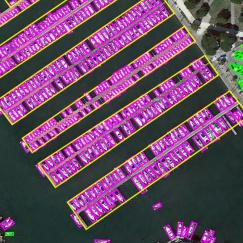Rotated Object Detection via Scale-invariant Mahalanobis Distance in Aerial Images
Rotated object detection in aerial images is a meaningful yet challenging task as objects are densely arranged and have arbitrary orientations. The eight-parameter (coordinates of box vectors) methods in rotated object detection usually use ln-norm losses (L1 loss, L2 loss, and smooth L1 loss) as loss functions. As ln-norm losses are mainly based on non-scale-invariant Minkowski distance, using ln-norm losses will lead to inconsistency with the detection metric rotational Intersection-over-Union (IoU) and training instability. To address the problems, we use Mahalanobis distance to calculate loss between the predicted and the target box vertices' vectors, proposing a new loss function called Mahalanobis Distance Loss (MDL) for eight-parameter rotated object detection. As Mahalanobis distance is scale-invariant, MDL is more consistent with detection metric and more stable during training than ln-norm losses. To alleviate the problem of boundary discontinuity like all other eight-parameter methods, we further take the minimum loss value to make MDL continuous at boundary cases. We achieve state-of-art performance on DOTA-v1.0 with the proposed method MDL. Furthermore, compared to the experiment that uses smooth L1 loss, we find that MDL performs better in rotated object detection.
PDF Abstract


